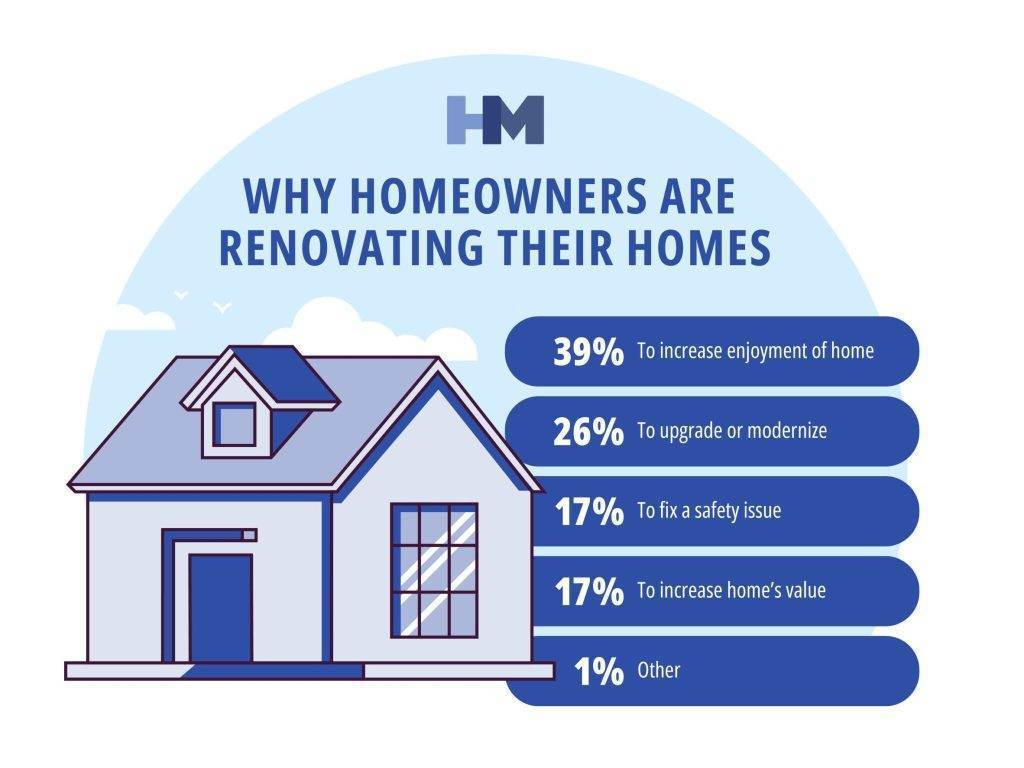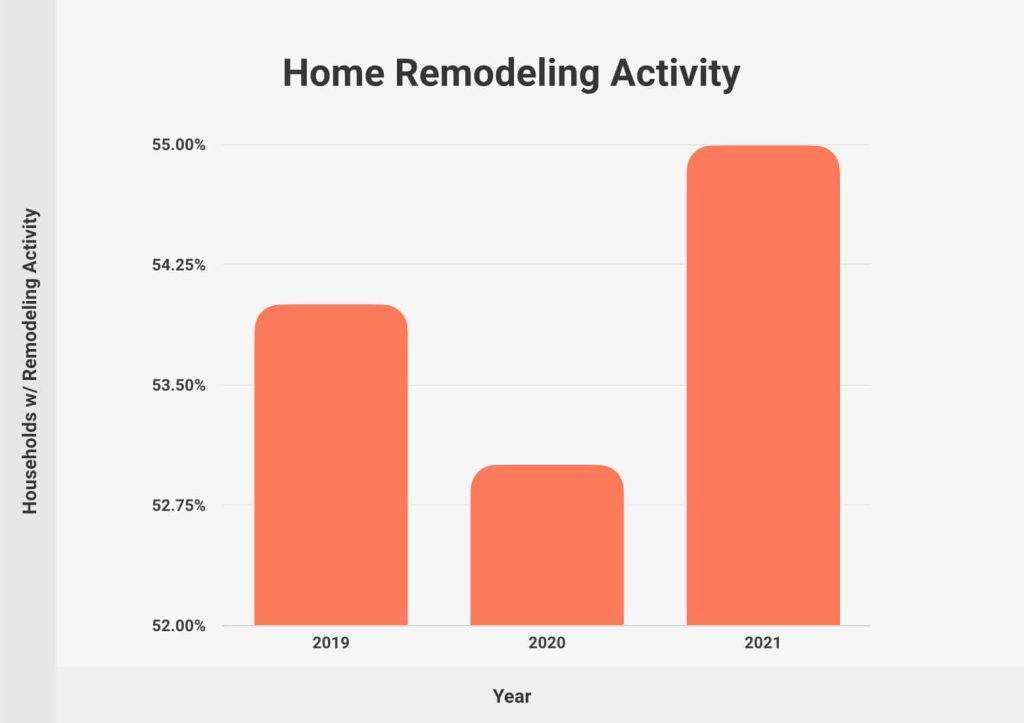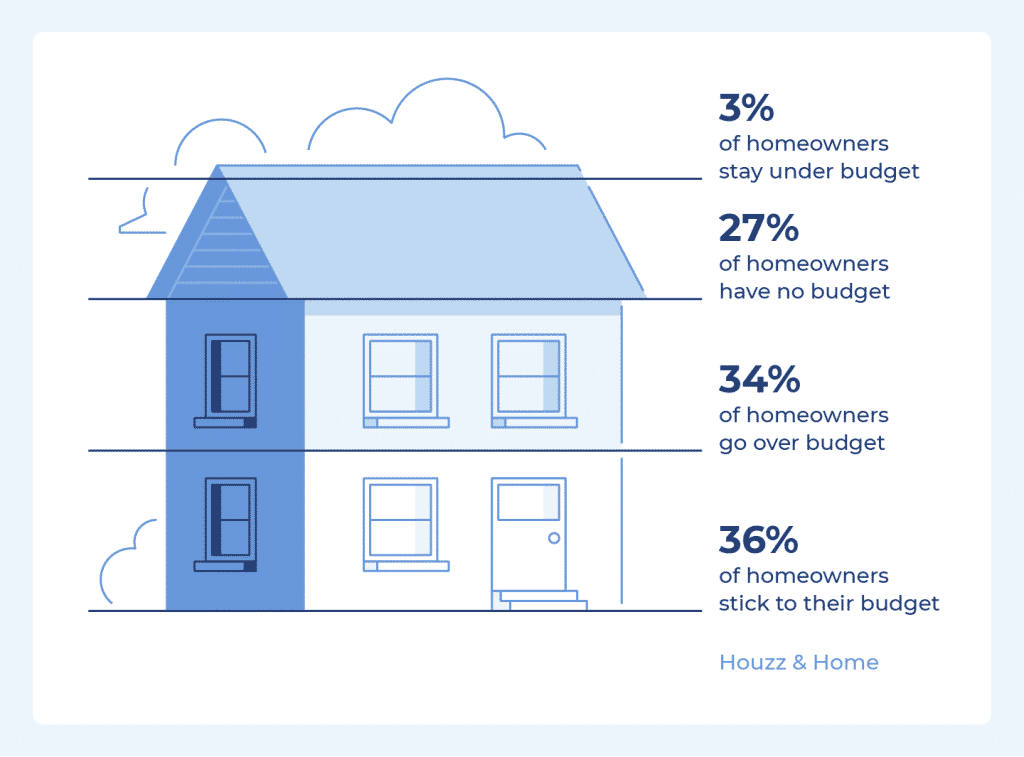Americans are known for their penchant for home improvement projects, but the frequency of these renovations may surprise you. From simple upgrades to full-scale remodels, Americans take pride in transforming their homes to suit their changing preferences and lifestyles. This article explores the question, “How often do Americans renovate their homes?” By examining the latest research and trends, we uncover fascinating insights into the habits and motivations driving this ongoing renovation culture. Whether you are a homeowner looking to embark on your own renovation journey or simply curious about the state of America’s housing market, this article offers valuable insights into the intriguing world of home renovations.
Factors influencing home renovation frequency
Economic conditions
The state of the economy plays a significant role in determining how often homeowners undertake renovation projects. During times of economic prosperity, when individuals have more disposable income, they are more likely to invest in home renovations. On the other hand, economic downturns can lead to a decrease in renovation frequency as people tighten their budgets and focus on essential expenses.
Age of home
The age of a home is another crucial factor in determining the frequency of renovations. Older homes often require more frequent renovations as the wear and tear over time can result in the need for repairs and upgrades. Conversely, newer homes may require less frequent renovations as they are built with modern materials and systems that are designed to last longer.
Change in family composition
Changes in family composition, such as the addition of a new family member or the emptying of the nest, can trigger the need for home renovations. Growing families may require additional bedrooms or functional spaces, while empty nesters may opt for downsizing and renovating their existing space to better suit their lifestyle.
Personal preferences
Personal preferences and tastes also influence the frequency of home renovations. Some individuals may have a strong desire to regularly update their living space to keep up with the latest design trends or simply to change the ambiance of their home. Others may prefer to maintain a consistent style and only renovate when necessary.
Statistics on home renovation frequency
Average time between renovations
According to recent studies, the average time between major home renovations in the United States is approximately 10 to 15 years. This time frame considers renovations that involve significant structural changes or additions to the home. For minor renovations that involve cosmetic updates, the average time between projects is shorter, ranging from 5 to 7 years.
Frequency of major renovations
The frequency of major renovations, as mentioned earlier, tends to occur every 10 to 15 years. These major renovations often involve upgrading the kitchen, bathrooms, or adding extensions to the home. Homeowners typically undertake these projects to improve functionality, increase the value of their property, or to accommodate lifestyle changes.
Frequency of minor renovations
Minor renovations, which are primarily focused on cosmetic improvements, occur more frequently than major renovations. Homeowners tend to engage in minor renovations every 5 to 7 years to refresh their living spaces, update finishes and fixtures, and enhance the overall aesthetic appeal of their homes.
Percentage of Americans who never renovate
Despite the significance of home renovations, there is a portion of the population that never engages in renovation projects. Recent surveys indicate that approximately 20% of Americans choose not to renovate their homes, either due to financial constraints, minimal interest in home improvement, or satisfaction with their current living conditions.
Percentage of Americans who renovate every 5-10 years
Around 30% of Americans opt to renovate their homes every 5 to 10 years. These individuals understand the importance of regular updates and maintenance to ensure the longevity and functionality of their homes. They recognize that periodic renovations can help them stay up to date with current design trends and technology.
Percentage of Americans who renovate every 10-15 years
The majority of Americans, approximately 40%, renovate their homes every 10 to 15 years. This group recognizes the need for occasional renovations to address wear and tear, improve energy efficiency, and maintain or increase their property value. These renovations often involve larger-scale projects that require careful planning and significant investment.
Percentage of Americans who renovate every 15-20 years
A smaller percentage, about 8% of Americans, tend to renovate their homes every 15 to 20 years. This group typically includes homeowners who prefer a more conservative approach to renovations and are content with longer intervals between projects. Renovations in this category often aim to address functional obsolescence or outdated design elements.
Percentage of Americans who renovate every 20 years or more
Finally, approximately 2% of Americans renovate their homes every 20 years or longer. These individuals may have unique circumstances or personal preferences that influence their infrequent renovation choices. Renovations within this category often focus on major updates and may involve significant transformations to modernize an older home.

This image is property of static.zippia.com.
Common reasons for home renovation
Improving functionality
One of the primary reasons people choose to renovate their homes is to improve functionality. Over time, certain areas of a home may become outdated or fail to meet the changing needs of the household. Renovating these spaces can enhance their practicality and ensure they align with the daily routines and lifestyle of the occupants.
Enhancing aesthetic appeal
Renovations frequently aim to enhance the aesthetic appeal of a home. Whether it involves updating the decor, refreshing finishes, or completely transforming the look and feel of a space, these renovations can greatly impact the overall ambiance and visual appeal of a home.
Increasing energy efficiency
Many homeowners renovate their homes to improve energy efficiency and lower utility costs. Upgrading insulation, replacing windows and doors, installing energy-efficient appliances, and utilizing sustainable materials are all common renovation projects aimed at reducing energy consumption and creating a more eco-friendly living environment.
Accommodating lifestyle changes
Changes in lifestyle often drive home renovations. Growing families may need additional space, resulting in room additions or basement conversions. Empty nesters may choose to downsize and renovate their existing home to create a more suitable and manageable living space. Renovations can also accommodate changing mobility needs, such as adding accessibility features for aging occupants.
Popular areas of home renovation
Bathrooms
Bathrooms are a popular area of focus for home renovations due to their high traffic and the potential for significant return on investment. Renovating bathrooms can involve updating fixtures, replacing outdated or malfunctioning plumbing, installing new vanities and countertops, or redesigning the entire layout to enhance functionality and create a spa-like retreat.
Kitchens
Kitchens are often considered the heart of the home and are another area commonly targeted for renovations. Homeowners typically undertake kitchen renovations to improve the design and flow, upgrade appliances and materials, create more storage space, and enhance the overall cooking and dining experience.
Living rooms
Living rooms are a central gathering space where homeowners frequently entertain guests and spend quality time with family. Renovations in this area often focus on improving comfort, updating furnishings, enhancing aesthetics, and integrating technology for entertainment purposes. Open floor plans, increased natural light, and improved connectivity with the outdoors are popular design choices for living room renovations.
Bedrooms
Renovating bedrooms can significantly impact the comfort and functionality of a home. Homeowners often seek to create a peaceful and relaxing sanctuary by updating the bedroom’s layout, installing built-in storage solutions, enhancing lighting, and selecting soothing paint colors or wallpapers. Additionally, renovations may involve creating flexible spaces that can accommodate work-from-home setups or other lifestyle requirements.
Outdoor spaces
Outdoor spaces, such as gardens, patios, and decks, have gained increasing attention in recent years. Homeowners recognize the value of creating inviting and functional outdoor areas that extend their living spaces and provide opportunities for relaxation and recreation. Renovations in this category focus on landscaping, hardscaping, outdoor kitchens, fire pits, and other features that enhance the usability and aesthetics of the outdoor environment.

This image is property of s43635.pcdn.co.
Average cost of home renovation
Total cost of typical renovation projects
The cost of home renovations varies widely depending on the size, scope, and complexity of the project. Major renovations involving structural changes and additions tend to have a higher price tag compared to minor cosmetic updates. On average, homeowners spend between $15,000 to $75,000 for small to medium-sized renovations, while larger-scale projects can range from $75,000 to several hundred thousand dollars.
Factors affecting renovation costs
Several factors influence the cost of home renovations. The size of the space being renovated, the quality of materials and finishes selected, the extent of structural modifications required, and the location of the property all play a role in determining the overall cost. Additionally, labor and contractor fees, permits, design services, and unforeseen issues that arise during the renovation process can significantly impact the final cost.
Average cost range for different types of renovations
The cost range for specific types of renovations can vary widely. For example, a minor bathroom renovation can cost between $10,000 to $20,000, while a major kitchen renovation can range from $25,000 to $50,000 or more. Additional factors that influence costs include the level of customization desired, the complexity of the project, and the region’s labor and material costs.
Benefits of regular home renovation
Increased property value
One of the significant benefits of regular home renovation is the potential to increase the property’s value. By keeping the home updated, well-maintained, and aligned with current design trends, homeowners can enhance its desirability in the real estate market. Renovations that improve functionality, energy efficiency, and aesthetics often lead to a higher resale value, offering a return on investment.
Improved comfort and livability
Home renovations can greatly improve the comfort and livability of a home. Upgrading insulation, replacing outdated heating and cooling systems, installing new windows, and upgrading appliances can contribute to a more comfortable living environment. Space planning and interior design improvements can also enhance the usability and flow of the home, making it a more enjoyable space to live in.
Reduced maintenance and repair expenses
Regular home renovations can help minimize future maintenance and repair expenses. By proactively addressing issues and updating components before they become major problems, homeowners can save significant costs in the long run. Renovations that involve replacing outdated or faulty plumbing, electrical systems, or structural components can prevent costly repairs and potential damage to other parts of the home.
Opportunity for personalization
Home renovations provide an excellent opportunity for homeowners to personalize their living spaces and create a home that reflects their unique tastes and preferences. By selecting finishes, materials, colors, and textures that align with their personal style, homeowners can infuse their personality into every corner of their home. This personalization adds a sense of pride and ownership and contributes to the overall satisfaction and enjoyment of the space.

This image is property of assets.site-static.com.
Challenges of frequent home renovation
Financial constraints
One of the significant challenges of frequent home renovation is the financial aspect. Renovations can be expensive, especially major projects that involve structural changes or additions. Homeowners must carefully consider their budget, financing options, and the return on investment before embarking on frequent renovations. Financial planning is crucial to avoid overextending resources and potentially causing financial stress.
Disruption of daily routine
Frequent renovations can disrupt the daily routine of homeowners and their families. Renovations often involve noise, dust, and the temporary loss of certain amenities or spaces within the home. Planning for alternative living arrangements, setting up temporary workspaces, and scheduling renovation activities during less disruptive times can help minimize the impact on daily life.
Finding reliable contractors and suppliers
Another challenge faced by homeowners undertaking frequent renovations is finding reliable and reputable contractors and suppliers. The success of a renovation project heavily relies on the expertise and professionalism of the hired professionals. Ensuring that contractors are properly licensed, have a good track record, and can complete the project within the expected timeframe and budget is essential. Similarly, sourcing high-quality materials and products from trustworthy suppliers is crucial to achieve long-lasting and satisfactory results.
Difficulty in decision-making
Frequent renovations require homeowners to make numerous decisions throughout the process. From selecting materials and finishes to making design choices and approving project timelines, the decision-making workload can be overwhelming. Homeowners must carefully consider their preferences, research the available options, and seek professional guidance when needed to ensure that each decision aligns with their goals and results in a successful renovation.
Future trends in home renovation frequency
Innovation in home design and technology
As technology continues to advance, it is expected to play a significant role in the future of home renovations. Home automation, smart home features, and energy-saving solutions are becoming increasingly popular among homeowners. The integration of intelligent systems, such as voice-controlled lighting and temperature control, is expected to become more prevalent in upcoming renovations.
Sustainable and eco-friendly renovation practices
With a growing focus on environmental sustainability, future home renovations are likely to embrace more eco-friendly practices. This may involve the use of sustainable materials, such as bamboo flooring or recycled countertops, as well as incorporating energy-efficient systems and renewable energy sources. As the demand for green renovations increases, homeowners and professionals alike will prioritize sustainable practices.
Preference for multi-functional spaces
The future of home renovations is leaning towards creating multi-functional spaces that can adapt to various needs and activities. Flexible designs that allow rooms to serve different purposes, such as a home office that can easily transform into a guest bedroom, will become more popular. Homeowners are seeking versatility and practicality in their living spaces to accommodate changing needs and maximize usability.
Integration of smart home features
As technology becomes more integrated into everyday life, the incorporation of smart home features in renovations is expected to become more prevalent. Homeowners are increasingly interested in controlling various aspects of their homes, such as security systems, lighting, and temperature, through their smartphones or voice commands. This trend is likely to continue, with more renovations incorporating smart home systems and connected devices.

This image is property of www.multivu.com.
Factors to consider before undertaking home renovation
Budget and financing
Before embarking on a home renovation, it is essential to establish a realistic budget based on the desired scope of the project. Homeowners should carefully consider their financial situation, explore financing options if necessary, and ensure they have sufficient funds to cover the renovation costs, including unexpected expenses that may arise.
Scope of the renovation project
Clearly defining the scope of the renovation project is crucial for successful planning and execution. Homeowners should identify their specific needs and goals, determine which areas of the home require renovation, and prioritize the different aspects of the project. By clearly defining the scope, homeowners can effectively communicate their expectations to professionals, obtain accurate cost estimates, and ensure that the project stays within budget and schedule.
Long-term plans for the property
Considering the long-term plans for the property is essential when undertaking a home renovation. Homeowners should evaluate how long they plan to stay in the home and whether the renovations align with their future needs and goals. It is also important to assess the potential resale value of the renovations, especially if there is a possibility of selling the property in the future.
Potential return on investment
Calculating the potential return on investment (ROI) of a renovation project is crucial for homeowners. Certain renovations, such as kitchen or bathroom upgrades, often have a higher ROI compared to others. Researching market trends, consulting with real estate professionals, and understanding the local housing market can help homeowners make informed decisions to maximize their return on investment.
Regulations and permits
Before starting a home renovation, homeowners should familiarize themselves with local regulations and permit requirements. Depending on the scope of the project, certain renovations may require permits or inspections to ensure compliance with building codes and safety standards. It is essential to obtain the necessary approvals and permits to avoid potential legal issues or delays during the renovation process.
Tips for successful home renovation projects
Plan and set clear goals
Effective planning is critical for successful home renovation projects. Homeowners should clearly define their goals, identify the scope of the project, and establish a realistic timeline and budget. Planning allows for better organization, smooth execution, and a higher chance of achieving the desired outcome.
Research and gather inspiration
Before starting a renovation, it is essential to conduct thorough research and gather inspiration from various sources. Exploring design trends, browsing home improvement magazines, and visiting showrooms or open houses can help homeowners visualize their desired outcome and make informed choices when selecting materials, finishes, and design elements.
Establish a realistic budget
Setting a realistic budget is crucial for ensuring that the renovation project remains financially viable. Homeowners should carefully consider all potential expenses, including labor, materials, permits, and unforeseen costs. It is advisable to allocate a contingency fund to account for unexpected surprises that may arise during the renovation process.
Hire qualified professionals
Working with qualified and reputable professionals is key to a successful home renovation. Homeowners should thoroughly research and interview potential contractors, architects, designers, and other professionals involved in the project. Checking references, reviewing portfolios, and verifying licenses and insurance coverage can help ensure that the chosen professionals have the necessary qualifications and experience to deliver a high-quality renovation.
Manage the renovation process effectively
Effective project management is essential for a smooth renovation process. Homeowners should establish clear lines of communication with the professionals involved, regularly monitor progress, and address any issues or concerns promptly. Staying organized, keeping documentation of all agreements and contracts, and maintaining open and transparent communication with the renovation team can contribute to a positive and successful renovation experience.
In conclusion, home renovation frequency is influenced by various factors, including economic conditions, age of the home, change in family composition, and personal preferences. Americans renovate their homes at different intervals, with major renovations occurring every 10 to 15 years, minor renovations every 5 to 7 years, and a small percentage of individuals choosing not to renovate at all. Common reasons for home renovations include improving functionality, enhancing aesthetic appeal, increasing energy efficiency, and accommodating lifestyle changes. Popular areas of renovation include bathrooms, kitchens, living rooms, bedrooms, and outdoor spaces. The average cost of home renovation varies depending on the project, with factors such as size, materials, labor, and location influencing the overall cost. Regular home renovations offer benefits such as increased property value, improved comfort and livability, reduced maintenance and repair expenses, and the opportunity for personalization. However, challenges may arise, including financial constraints, disruption of daily routine, finding reliable contractors, and decision-making difficulties. Future trends in home renovation point towards innovation in design and technology, sustainable practices, multi-functional spaces, and the integration of smart home features. Before undertaking a renovation, factors such as budget and financing, the scope of the project, long-term plans for the property, potential return on investment, and regulations and permits should be considered. Tips for successful home renovation projects include effective planning, research and gathering inspiration, establishing a realistic budget, hiring qualified professionals, and managing the renovation process effectively. By carefully considering these factors and following these tips, homeowners can achieve successful and satisfying home renovation projects.

This image is property of raleighrealtyhomes.com.
